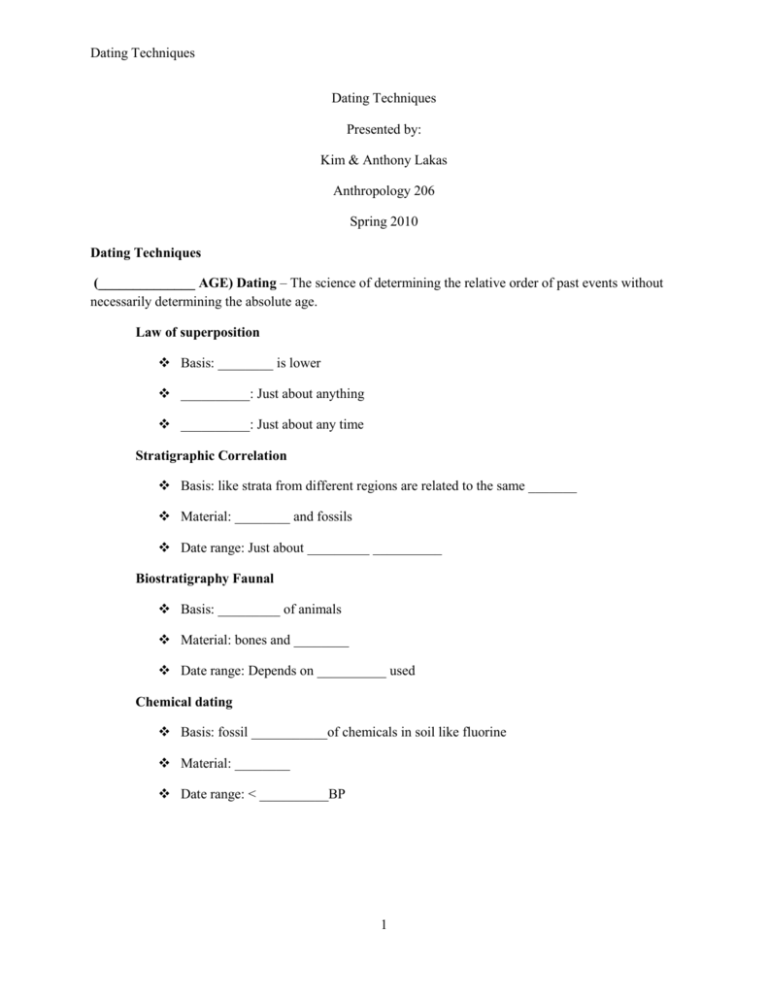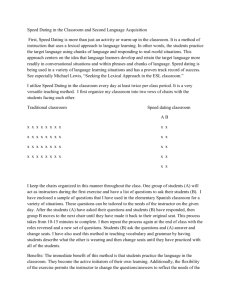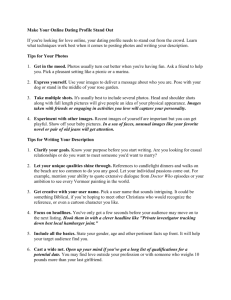Dating Techniques lecture notes
advertisement

Dating Techniques Dating Techniques Presented by: Kim & Anthony Lakas Anthropology 206 Spring 2010 Dating Techniques (______________ AGE) Dating – The science of determining the relative order of past events without necessarily determining the absolute age. Law of superposition Basis: ________ is lower __________: Just about anything __________: Just about any time Stratigraphic Correlation Basis: like strata from different regions are related to the same _______ Material: ________ and fossils Date range: Just about _________ __________ Biostratigraphy Faunal Basis: _________ of animals Material: bones and ________ Date range: Depends on __________ used Chemical dating Basis: fossil ___________of chemicals in soil like fluorine Material: ________ Date range: < __________BP 1 Dating Techniques Cultural Dating Basis: artifacts are __________ _________ Material: artifacts Date range: up to _____ mya Oxygen isotopes in deep sea cores Basis: ratio of oxygen __________in foraminifera reflects sea temperature Material: deep sea cores Date range: ? _____________________ Basis: direction of_____________ in magnetic minerals when they solidified Material: magnetic minerals Date range: Sequence currently covers last _____mya Numerical (_________________) Dating – is a dating method that provides an actual age in years for a defined piece of material or event. Dendrochonology Basis: ____________ growth in tree rings/rainfall Material: Specific tree species Date Range: ________________BP Radio Carbon (____-_____) Half life Basis: Ratio of C-14 to ____-_____ Half life: ________ years +/- sigma Material: anything organic Date Range:____________________ BP 2 Dating Techniques Beryllium-10/Be-9 Basis: radio isotope _______ Half life _______M.Y. Material: beryllium containing rock Date Range: ? K-40/AR-40 AR-40/AR-39 Basis: radio isotope decay Half life: ____________ years Material: volcanic rock Date Range: > ________ yBP Amino Acid Dating Basis: ____________ - process by which L form amino acids changes to D forms. Material: bone, some shell Date Range: 1mya to ______________BP Fission Tracks Basis: fission tracks from radio _________ decay Material: volcanic glasses Date Range: up to ______MYA Electron spin resonance Basis: concentrations of radio isotopes Material: _____, ________ Date Range: several thousand to >1 mya 3 Dating Techniques Luminescence (_______ _________) Basis: _________ ________ Material: ceramics, some stone, sediments Date Range: up to 800,000 yBP 4







